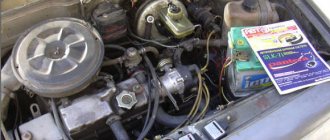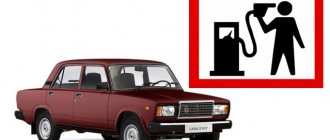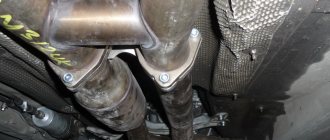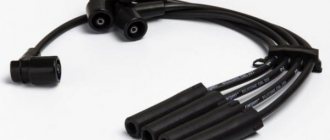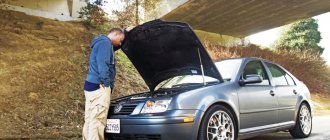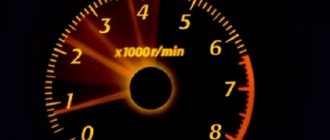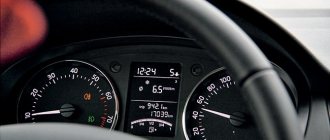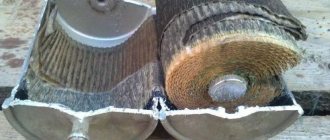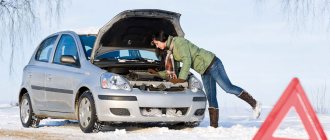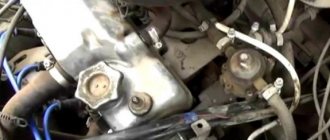Popping sounds in the muffler - how to get out from under fire?
Popping noises in the muffler are a very unpleasant manifestation of engine malfunction. This “illness” is more typical for carburetor units and clearly indicates a problem with the gas distribution or ignition systems.
Shoots at the muffler - check the carburetor!
Often it is not possible to immediately figure out why the muffler is shooting. Contrary to the popular belief that the culprit is a violation of the valve timing, there may be other reasons for this behavior of the engine. Before you begin troubleshooting the “engine” that led to shooting in the car’s muffler, you should understand the nature of this phenomenon. A loud shot indicates that a flammable mixture is igniting in the exhaust system.
First of all, you should check the condition and settings of the carburetor, as well as the air filter. As practice shows, quite often an over-enriched fuel mixture, experiencing a lack of air, does not burn in full during the compression stroke and is partially transferred to the exhaust manifold and further to the muffler. When gasoline accumulates in a closed space at high temperatures, it ignites.
The troubleshooting algorithm is simple:
- We disassemble the air filter and change the filter element;
- We check the fuel supply adjustments on the carburetor.
Adjusting the thermal gap when popping in the muffler
As soon as interruptions in engine operation begin, experienced and novice drivers try to test it in operation under different loads. If you hear popping noises in the muffler at idle, medium and high speeds, then there is a high probability of poor adjustment of the thermal clearance of the cylinder head valves. The fact that it is necessary to take out equipment to adjust the valves may be indicated by the appearance of popping noises after the engine warms up.
The camshaft pushers or cams must have a thermal clearance at the point of contact with the valve stem. After heating, the metal parts heat up and increase in size, which leads to a decrease in this gap.
When adjusted correctly, the valve disc always fits very tightly into the seat. If there is no thermal gap, then the valve is not able to completely close the gap. At the moment of the compression stroke, the fuel mixture partially exits through a small gap into the exhaust manifold, where it ignites. Unpleasant pops can be “treated” by simply adjusting the thermal clearance of the cylinder head valves.
Late ignition is the cause of shots in the muffler
Late ignition of the fuel mixture in the combustion chamber can also be the reason why shots are fired into the muffler. This is due to incorrect ignition settings. At the moment of overcoming the top dead center (TDC) on the compression stroke, a spark should appear between the contacts of the spark plug, which ignites the fuel mixture.
If the ignition is slightly delayed, then ignition occurs when the piston moves downwards at full speed, completing the power stroke. At this point, the exhaust valve begins to open. At the moment of ignition, the fuel mixture rushes into the exhaust manifold and causes a pop.
Advice to motorists - take care of the engine
Shots in the exhaust pipe are a consequence of lack of control and violation of engine adjustments. The popping sounds themselves only indicate the need to check the fuel system, gas distribution and ignition. If this is not done immediately when unpleasant “symptoms” appear, then you can completely ruin the engine.
It is at such moments that there is a high probability of damage to the valves, exhaust system, and even a car fire. There is also a positive aspect in that the engine began to attract attention in this way. Finding the causes of the malfunction will inevitably force the driver to check the condition of the internal combustion engine systems, make the necessary adjustments and replace consumables.
Site about off-road vehicles, SUVs, off-road vehicles
Difficulty starting a cold and warm UMZ-417 and UMZ-421 engine with a K-151 carburetor, interruptions in its operation causing failures, jerking or twitching while the vehicle is moving, as well as its sluggish acceleration and increased fuel consumption, can also be caused not only malfunctions in the ignition and fuel supply systems, but also poor performance and failure of the systems and components of the carburetor itself.
Unstable operation of the UMZ-417 and UMZ-421 engines at idle associated with the K-151 carburetor.
Unstable operation of the engine at idle speed when the idle system and float mechanism of the K-151 carburetor are in good working order can be caused by malfunctions of its EPHH pneumatic valve or elements of the EPHH system - a microswitch, solenoid valve and control unit.
Interruptions in the operation of UMZ-417 and UMZ-421 engines at partial and full load modes associated with the K-151 carburetor.
Interruptions in engine operation at partial and full loads and, as a consequence, twitching of the car in the form of a series of light short jerks, following one after another, indicate disturbances in the operation of the main metering systems of the K-151 carburetor, due to contamination of their metering elements and channels, or leakage of additional air in the connections of the carburetor body parts due to damage to the sealing gaskets or warping of the mating surfaces.
Engine malfunctions in these modes can also be caused by an excessively low fuel level in the float chamber, in which the air-fuel mixture becomes lean due to a high vacuum in the main air channels of the carburetor, and also the econostat does not come into operation in a timely manner.
Dips and jerks during operation of the UMZ-417 and UMZ-421 engines associated with the K-151 carburetor.
Long dips, up to five seconds, a decrease in acceleration down to deceleration and jerks lasting no more than half a second, during vigorous acceleration of the car with a sharp opening of the throttle valves, are caused by malfunctions of the accelerator pump - damage to its diaphragm, sticking of the drive lever, clogged valves and nozzle, etc. , or a reduced fuel level in the float chamber, at which the pump flow is reduced.
If the fuel or emulsion nozzle of the idle system is clogged, a failure may occur even with a smooth opening of the throttle valve. At the same time, the engine is extremely unstable when idling.
During normal operation of the idle system, the cause of failure may be improper adjustment of the fuel level or clogging of the main fuel jets of the K-151 carburetor. An attempt to open the throttle valves when it fails due to clogged nozzles may result in a complete engine stop. The same thing happens if small diffusers are installed incorrectly after completely disassembling the carburetor, for example, to wash it.
Rocking of the car or a series of deep failures in the operation of the UMZ-417 and UMZ-421 engines associated with the K-151 carburetor.
Rocking of the car or a series of deep dips after short-term operation of the engine with the throttle valves fully open, which stops after they are partially closed, is caused by a violation of the fuel supply.
If the fuel pump is working properly and the fuel line is clean, the cause of rocking is a clogged carburetor fuel filter or a stuck fuel valve needle in the closed position.
Insufficient power of the UMZ-417 and UMZ-421 engines and their low throttle response.
Insufficient engine power and low throttle response are caused by incomplete opening of the throttle valves as a result of a malfunction of their drive. The same is observed when the fuel level in the carburetor float chamber decreases.
Increased fuel consumption when operating the UMZ-417 and UMZ-421 engines.
It is caused by a complex of the above malfunctions in various combinations and is observed when the carburetor starting device is incorrectly adjusted, the fuel level is high, the air jets are clogged, the fuel jets are not tightened tightly, so in K-151 carburetors the tightening of the idle system jet block is especially often loosened.
And also in case of malfunctions or shutdown of the EPH system, fuel leakage from under the screw securing the fitting block or the fuel supply hose.
Over-lean or over-rich air-fuel mixture.
Most malfunctions of K-151 carburetors, and therefore of UMZ-417 and UMZ-421 engines in general, are in one way or another associated with over-leaning or over-riching of the air-fuel mixture.
Additional external subjective signs of an over-lean mixture are popping noises in the carburetor when starting the engine and its overheating due to the slow combustion of such a mixture throughout almost the entire operating cycle.
Why does it shoot at the silencer? List of causes of popping sounds from the muffler
Before you came here to read this article about the causes of explosions in the muffler, you have probably heard such pops more than once from other cars - most often old wrecks. This startling bang from the muffler is usually accompanied by fearful and hateful looks, and for the driver who is responsible for this noise, some level of shame for disturbing the quiet environment with such a bang. Let's find out why the engine shoots into the muffler, what are the causes of these pops and explosions, and what does the popping into the muffler mean during certain accompanying engine actions.
Popping sounds from the muffler - what is it?
This deafening blast comes from the exhaust pipe of your car. The pop can shoot out at any time, but it typically shoots into the muffler most often when you try to start your car or when you take your foot off the gas pedal and the engine speed drops. The firing occurs when unburnt fuel leaves the engine, but as it moves, it ignites somewhere in the vehicle's exhaust system. This can happen directly in the engine or later down the line past the muffler resonator. When ignited, this mixture of fuel and air tends to expand at an insane speed, which is why there is a loud bang in the muffler.
Carburetor not tuned
Often the reason that the engine shoots into the muffler is an incorrectly configured carburetor. Its task is to create a fuel-air mixture, which is then supplied to the engine. If it is configured in such a way that the mixture is oversaturated with gasoline, a situation similar to that described above is created. The solution here is to check and adjust the “carb”.
The first step is to check the fuel level in the chamber where the float is located. Each carburetor is individually adjusted and has its own level. However, if its cover is removed, the float should be flush with the level of the cover. If this is not the case, adjust the level. Also be sure to check the integrity of the float . If it is damaged, fuel may leak into it, causing it to display the level incorrectly.
The reason that the carburetor shoots into the muffler may also be the jets. They are either configured incorrectly or become clogged over time. If the air jet does not supply enough air, the mixture becomes oversaturated with gasoline with the result described above. Often this malfunction occurs when the engine goes from idle to higher speeds, or with a sharp increase in speed (acceleration). It is necessary to check the condition of the jets and clean them if necessary.
| Air/fuel ratio | Description | A comment |
| 6/1 — 7/1 | Extremely rich mixture. Ignition failure. | Rich mixture. Long burning, low temperature. |
| 7/1 — 12/1 | Overrich mixture. | |
| 12/1 — 13/1 | Rich mixture. Maximum power. | |
| 13/1 — 14,7/1 | Slightly enriched mixture. | Normal mixture. |
| 14,7/1 | Chemically ideal ratio. | |
| 14,7/1 — 16/1 | Slightly lean mixture. | |
| 16/1 — 18/1 | Poor mixture. Maximum efficiency. | Poor mixture. Fast combustion, high temperature. |
| 18/1 — 20/1 | Over-lean mixture. | |
| 20/1 — 22/1 | Extremely lean mixture. Ignition failure. |
Can a popping sound in the muffler damage the engine?
Sharp sounds from the exhaust system are a consequence of inaccurate adjustment of the internal combustion engine or a failure of its settings. The following systems need to be checked:
- gas distribution mechanism;
- fuel supply system;
- ignition system;
- ICE sensors (in injection engines).
Popping noises do not pose any particular danger to the engine, but if you delay troubleshooting, problems cannot be avoided. A delay in restoring faulty components can lead to destruction of the valves and problems in the exhaust system. Sometimes such a breakdown even leads to a car fire.
But there are also positive aspects to the “sneezing” of the muffler - this is how the car makes it clear that there is a malfunction that needs to be fixed. Before repairs, it is necessary to carry out comprehensive diagnostics of the motor. Sometimes you need to adjust or replace some consumables.
High voltage wires
When carrying out repairs affecting the ignition system, the high-voltage wires may be connected incorrectly. In this case, the spark will not occur in time with the compression cycle, resulting in popping sounds. Even if the engine starts, its power is not enough to move the car.
To diagnose a malfunction, you should check the connection of the wires from the spark plugs to the distributor. You should push off from the mark located on the cover. The connection of high-voltage wires must correspond to the car model. For example, the location of high-voltage wires in the VAZ 2109 is shown below.
Why does the silencer shoot: reasons
The main reason for the appearance of pops is incomplete combustion of fuel. Once it enters the exhaust system, it ignites. The process is accompanied by a noise similar to cotton. The force of the explosion depends on the amount of unburned fuel. Sometimes you can even hear a whole line of shots. By the way, sometimes it shoots into the muffler when the gas is suddenly released or when you press it - and a lot of smoke comes out of the exhaust pipe. A breakdown is indicated by a loss of internal combustion engine power and an increase in fuel consumption.
There are other reasons why popping occurs.
Air filter
The fuel mixture is formed from fuel and air - the components must be mixed in certain proportions. The filter does not allow air to pass through if it is clogged. As a result, the lack of oxygen will lead to incomplete combustion of the fuel. Through the manifold, the fuel enters the exhaust system, where an explosion occurs as a result of heating.
Carburetor
An explosion in the exhaust system can also occur due to incorrect carburetor settings. The purpose of the unit is to form the correct air-fuel mixture. There should not be a lot of fuel in the mixture, otherwise everything described in the previous paragraph will happen. Popping noises will only be heard when the gas is released.
Switch
Failure of the commutator usually makes it impossible to start the motor. If attempts are made to start the car engine, popping noises will appear. To accurately diagnose switch failure, you should install a new or known-good device. If the engine no longer fires, then the switch needs to be changed - it is not profitable to repair it.
This malfunction often manifests itself in the early stages. This is usually accompanied by instability of speed. When you press the accelerator sharply, the car picks up speed with dips. Popping noises are also heard.
How to diagnose and what exactly needs to be checked?
First, you need to check the air filter located at the entrance to the exhaust system. If it is very dirty, it will have to be replaced, since the air filter cannot be cleaned. Problems can be avoided if you change the element on time.
If the carburetor is faulty, you need to check the gasoline chamber in which the float is located. The settings for all carburetors are individual, so the level is required in each case. The float should be level with the lid. Otherwise, the carburetor needs to be adjusted.
The float itself may show an incorrect value due to damage. For example, if this element has a hole, fuel penetrates inside it. Naturally, after this the readings will be incorrect.
When diagnosing, you need to check the spark plugs and replace failed elements. New spark plugs must have the same heat rating as the removed ones.
The cylinder head thermal clearance needs to be adjusted - if it is incorrect. The valves on all cylinders are manually adjusted when cold.
Problems with the timing belt can be resolved by tightening it or replacing it (if tightening does not produce results). But if there is significant wear, we definitely replace the toothed pulley. Worn valves can be sanded if they are scratched, or ground in if there are rough spots.
Shots in the muffler area occur regardless of the type of engine - be it an injector or a carburetor. They happen at idle and when the engine is warm. But this is only an external sign - behind it lies serious problems that need to be solved immediately.
The main reasons for the problem
Popping noises in the muffler can occur for the following reasons:
- Explosion of a flammable mixture that did not have time to burn during the operating cycle. Such pops can occur in systems with both a carburetor and an injector.
- Valve timing mismatch.
- The car air filter is dirty.
- Failure in the size of the thermal gap on the cylinder head valve (if the problem appears at high or low speeds).
- Late ignition is also a common reason why the muffler shoots. In this case, it is inevitable that some amount of fuel will be released into the collector.
- Spark too weak. This may be due to problems with spark plugs, toggle switches, contact groups, and wire contacts.
- Timing belt stretching. In this case, shots are heard only when the system is warmed up, and not immediately when you press the gas.
- Popping noises in the injector may be due to insufficient reliability of the sensor contacts.
Valve clearances
Thermal gap may also be the reason why ZIL shoots into the carburetor (the same malfunction is observed on other cars). If the engine was repaired and the distance between the camshaft cam and the pusher was accidentally reduced, then there will be popping noises during the startup process. Also, thermal clearances may change if the necessary adjustments have not been made. Shrinkage occurs and surfaces may become deformed. If you do nothing, the engine will fire.
To diagnose the gaps, you need to remove the valve cover and measure the gaps with feeler gauges. If you do not adjust them, the valves may burn out. There is no way around this without repairs. Flames will erupt into the intake manifold even if the damaged valve is adjusted correctly.
Fuel system overflow
When the carburetor delivers too much gasoline, some of the fuel and air mixture enters the exhaust manifold and the engine shoots out the exhaust pipe. Typically, such a problem is diagnosed by the pronounced smell of gasoline in the cabin and under the hood, as well as by the black sooty electrodes of the spark plugs. At the same time, black smoke comes out of the exhaust pipe, often mixed with soot.
The first thing to do is check the air filter. When it is heavily clogged, the engine draws in more fuel than necessary. It could also be that the needle valve inside the float chamber has lost seal or that the pump diaphragm has ruptured.
If there is an excessive supply of gasoline, the idle speed fluctuates or increases to 2-2.5 thousand per minute. When releasing the gas while driving, the problem of shots also arises if the speed is turned on.
Popping sound in muffler when pressing gas
If the car does not start, and shots are clearly heard in the muffler, this is almost a guarantee that the device is in a state close to an explosion. You should immediately stop trying to start the car and take the following measures:
- Inspect the candles. If the electrodes are dirty, replace them.
- Tighten or replace the timing belt if necessary.
- Check the functionality of the crankshaft position sensor.
- Change the pressure inside the fuel line. Replace the pump if the reading is below 3.
- Check the compression level in the engine. The occurrence of rings can be one of the causes of lumbago. To solve the problem, you can try draining the oil and pouring kerosene into the cylinders. Then unscrew the spark plugs and turn the starter. Give the car time to stand, then drain the kerosene and pour in new oil. Try to start the engine.
- Try starting with the DTOZh sensor disabled. This will provide clarity in determining the cause.
Equilibrium mechanism
Why the VAZ-2107 carburetor does not start and what to do
This mechanism is designed to reduce strong engine vibration. The design is quite strong and reliable. The main failure is a broken gear. The situation can be resolved by replacing the toothed disc.
As a result, it should be said that most of the above situations can be avoided if quality maintenance is carried out on the car and, in particular, the engine. The Oka is considered a rather capricious machine, so it is recommended to constantly monitor and care for it so that it is always on the move and helps out at the right time.
When the injector and diesel fire
In old power diesel devices, it was possible to manually mechanically adjust the timing of diesel injection. If the adjustment was carried out incorrectly, the fuel was compressed too much and white smoke came out of the engine. Today, such a situation is rare, since everything is controlled by electronics, including VAZ and Gazelle.
But there are other reasons that cause shooting in modern systems:
- The lambda probe, DBP and mass flow sensors are broken, or the throttle position is incorrectly set.
- The high voltage ignition unit is faulty.
- Controller errors.
- The working surface of the crankshaft position sensor is excessively contaminated with metal shavings.
If it is assumed that the problem is due to controller errors, then you can try resetting the settings by disconnecting the battery for fifteen minutes. Even if the method helped, it is still recommended to check the car at a service center to avoid a recurrence of the situation.
If, when releasing gas, the power unit often fires, then there is a possibility of problems with the gas equipment of the car. The system supplies liquefied propane to the cylinders under the control of a separate electronic unit; the process involves a reducer and valves along with a cylinder. If any breakdowns occur in the system, the gas will overflow, resulting in popping noises. There is no need to explain why to go to the service center in this case - independent repair is impossible.

